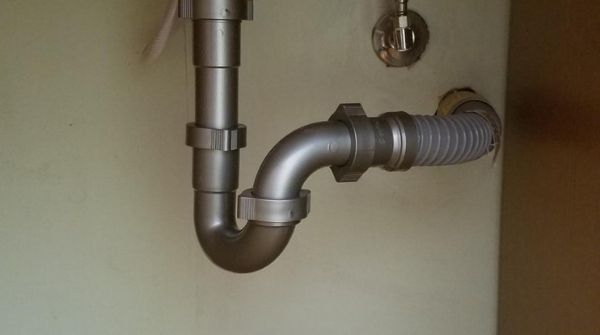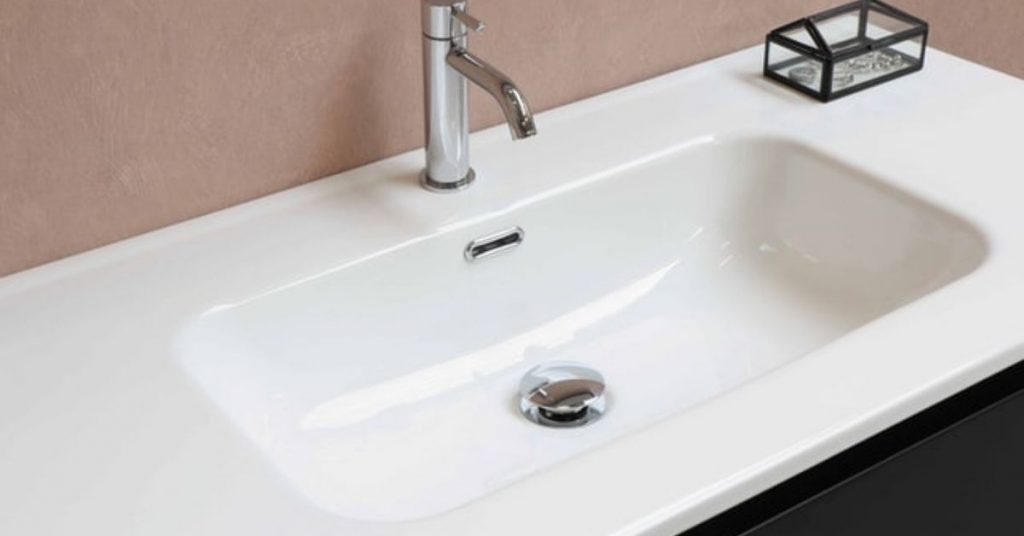A kitchen or bathroom sink smelling like a sewer is not unusual. All fixtures in your house have a drain but those drains are not independent. They all drain into the main house drainpipe that is connected to the city’s sewer lines.

If one fixture’s drainpipe has a problem it will therefore most likely affect the other others. Think of your house plumbing like a tree. The branches represent each fixture’s drainpipe while the trunk represent the main house drainpipe.
Causes
- Dry P-Trap: If a sink is not used regularly, the water in its P-trap (a curved section of pipe under the sink) can evaporate, allowing sewer gases to enter the room through the drain.
- Blocked Vent Pipe: The vent pipe connected to the plumbing system is designed to release sewer gases safely to the outside. If this pipe becomes blocked or obstructed, it can cause odors to back up into the sink.
- Clogged or Dirty Drain: Buildup of debris, hair, or grease in the drain can produce foul odors.
Apart from the sink, other fixtures in the house are also affected by this problem. You can sometimes also hear the bathtub/shower drain gurgling when you flush the toilet.
How do You Get Rid of Sewer Smell in Sink?
Fixing a sink with a sewer or rotten eggs smell is actually very easy and you don’t need even need to call in a plumber. Start with the easiest method and if it doesn’t work try the next one.
- Run Water: To prevent the P-trap from drying out and sewer odors from entering the sink, run water in unused sinks periodically. This will refill the P-trap and create a seal.
- Check Vent Pipe: Inspect the vent pipe on your roof or exterior wall to ensure it’s not obstructed by debris or other objects. Clear any blockages if necessary.
- Clean the Drain: Regularly clean the sink’s drain using a drain cleaner or a mixture of baking soda and vinegar to dissolve any buildup. Removing debris from the drain can help eliminate odors.
- Use a Drain Strainer: Install a drain strainer or stopper to prevent debris from entering the drain in the first place.
- Professional Inspection: If the odor persists or you suspect a more complex issue with your plumbing system, it’s advisable to consult a professional plumber for a thorough inspection and repair.
Here is a detailed guide on how to go about it:
1. Fix the Sink’s P-Trap
Every fixture with a drain in your house has a P-trap. If you look under you kitchen or bathroom sink you will see it.

A P-trap is a curved pipe which looks like and inverted P or a U. But why do drains need a P-trap? There are 2 reasons:
- When something that is not supposed to be washed down the drain ends up being washed down, it is trapped in the P-trap preventing it from clogging the drainpipe further down where it would be harder to pull out.
- Because of its shape, it always holds a little amount of water. This water acts as barrier for sewer gases, preventing them from coming up into the house.
If either your kitchen sink or bathroom sink has not been used for some time, the water in the P-trap will evaporate breaking the barrier. Sewer gases will therefore start coming out of the sink drain and hence the sewage smell.
Opening your sink’s faucet and allowing water to run for a few seconds will replenish the water evaporated from the P-trap. This will create the barrier necessary to prevent the sewer gases from flowing out from the sink again.
If your sink is always in use, there is no way that the water can evaporate that fast from the P-trap. This means that there might be a leak from the P-trap.
Turn on the water and duck under the sink to see if there are any leaks. The leak usually comes from either of the 2 trap’s connections, or a cracked plastic.
If the leak is coming from a loose connection, use an adjustable wrench to tighten the connection. Wipe the trap dry with a rag and wait to see if the leak has stopped or you need to tighten some more.
If unfortunately the P-trap is cracked, you will need to replace it. Remove it and take it with you to a home improvement store and buy a matching one.
False Results?
The above repair is not always foolproof and can give you a false result. This is usually the case if the problem is not the sink’s P-trap but a clogged vent stack.
If the vent stack in your house is clogged, it means sewer gases cannot flow out. For proper functioning of the drains, air has to flow in and out of the vent stack.
When you flush the toilet, a vacuum is created in the drainpipe which sucks in the water from the sink’s P-trap. The sewer gases that should have flown out through the vent stuck are then forced out through the sink drain.
To be sure that this is not the issue, open your sink water faucet and let the water run for about 20 seconds. That way you know that the sink’s P-trap is full of water.
Flush the toilet (or have someone do it for you) and reason carefully for any gurgling sound from the P-trap. If that happens, it means water is being sucked from the P-trap. You will therefore need to unclog the vent.
On the other hand if it’s all quiet inside the trap and there are no leaks, it means your problem is solved.
It is always a good practice to open water to all your fixtures and let it run for a few seconds every time you come from a vacation/trip. Remember to flush your toilet as well.
2. Unclog Your Vent Stack

It is not unusual to have a clogged vent. The common culprits for these are leaves, rodents’ carcasses, trash/debris and even snow.
- Climb to the roof of your house armed with a garden hose connected to a water source. You can even connect a nozzle to the front of the hose for maximum water pressure.
- Start by remove any visible blockages from the opening of the vent with you bare hand. Reach deeper to see if there is still more trash you can pull out.
- Insert the hose inside the vent and have someone turn on the water. The force and weight of the water will force anything that is clogging the vent to be washed down the drain.
- If you have a nasty clog in the vent, you will notice water flowing out from the top of the vent. This means you have to upgrade to a more powerful tool.
- Get a toilet auger and feed the cable down the vent stack. If you encounter resistance, start cranking the auger handle clockwise and counterclockwise until you push the auger head through it.
- Repeat garden hose and water step until water starts flowing down the vent freely. At that point the vent is fully unclogged.
3. Clean the Sink’s Drain and Overflow
Soap and other organic waste from the sink will after some time get trapped in the sink’s P-trap and overflow pipe. When this waste stats to decompose, a pungent sewer or rotten eggs smell will start coming out of the sink.
Cleaning the sink drain trap and overflow is actually an easy task that you should do often even if there is no smell. Baking soda and vinegar are 2 of the best products to use. While bleach works effectively, it is very bad for the environment and dangerous if you are on a septic system as it will kill the good bacteria in the septic tank.
Here is how to clean a badly smelling kitchen/bathroom sink:
- Pour half a cup of baking soda down the sink drain.
- add half a cup vinegar slowly. Remember these 2 products reacts quite fast and you do not want to have a mess.
- wait for 30 minutes
- Blast hot water down the sink drain. This water will wash down and rinse down everything down the drain.
Now that you have cleaned the P-trap, go ahead and clean the sink overflow.
- Stick a funnel through the sink overflow opening.
- Pour half a cup of baking soda
- Add another half a cup of vinegar and wait for 30 minutes.
- Blast hot water down the overflow to rinse and remove any lingering debris.
If you follow this detailed guide you will without a doubt get rid of the sewer smell coming from your sink. You can also read more about smell shower/bathtub drains in this post.






